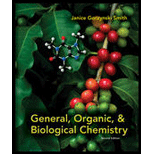
Concept explainers
Write the formula for the ionic compound formed from the sulfite anion (SO32–) and each cation:
- (a) K+;
- (b) Ba2+;
- (c) Al3+;
- (d) Zn2+.
(a)
Interpretation:
The formula of the ionic compound formed when
Answer to Problem 3.66AP
The formula of the ionic compound formed when
Explanation of Solution
When potassium cation
The charges are not equal in magnitude, two potassium ions and three sulfite ions are required to balance the charge.
The formula of the ionic compound formed when
(b)
Interpretation:
The formula of the ionic compound formed when
Answer to Problem 3.66AP
The formula of the ionic compound formed when
Explanation of Solution
When barium cation
The charges are equal in magnitude, and one of each ion is needed to balance the charge.
The formula of the ionic compound formed when
(c)
Interpretation:
The formula of the ionic compound formed when
Answer to Problem 3.66AP
The formula of the ionic compound formed when
Explanation of Solution
When aluminum cation
The charges are not equal in magnitude, two aluminum ions and three sulfite ions are required to balance the charge.
The formula of the ionic compound formed when
(d)
Interpretation:
The formula of the ionic compound formed when
Answer to Problem 3.66AP
The formula of the ionic compound formed when
Explanation of Solution
When zinc cation
The charges are equal in magnitude, and one of each ion is needed to balance the charge.
The formula of the ionic compound formed when
Want to see more full solutions like this?
Chapter 3 Solutions
General, Organic, & Biological Chemistry
- Na3VO4 is used to deactivate enzymes in some biochemical analyses.(a) What is the charge on the anion in this salt? That is, what is n in the formula VO^n−4 ?arrow_forward2-98 Explain how the ionization energy of atoms changes when proceeding down a group of the Periodic Table and explain why this change occurs.arrow_forward3-78 Nitrous oxide, N20, laughing gas, is a colorless, nontoxic, tasteless, and odorless gas. It is used as an inhalation anesthetic in dental and other surgeries. Because nitrous oxide is soluble in vegetable oils (fats), it is used commercially as a propellant in whipped toppings Nitrous oxide dissolves in fats. The gas is added under pressure to cans of whipped topping. When the valve is opened, the gas expands, thus expanding (whipping) the topping and forcing it out of the can. (a) How many valence electrons are present in a molecule of N20? (b) Write two equivalent contributing structures for this molecule. The connectivity in nitrous oxide is NNO. (c) Explain why the following is not an acceptable contributing structure:arrow_forward
- 2-59 You are presented with a Lewis dot structure of element X as X.. To which two groups in the Periodic Table might this element belong?arrow_forwardThe formula of barium acetate is (a) Ba(CH3CO2)2 (b) BaCH3CO2 (c) BaMnO4 (d) BaCO3arrow_forward3-46 Which formulas are not correct? For each that is not correct, write the correct formula. (a) Calcium oxide; CaO2 (b) Lithium oxide; LiO (c) Sodium hydrogen phosphate; NaHPO4 (d) Ammonium nitrate; NH4NO3arrow_forward
- Explain in great detail how to name K2SO3 and Fe2(SO3)3 compounds. What type of compounds are they? What are the charges on the metals? How are the nomenclature rules different for these two compounds?arrow_forwardCalculate the mass of vanadium(V) oxide (V2O5) that contains a trillion (1.00*10^12) vanadium atoms.arrow_forwardwhat ions are present in (NH4)2SO4? also, when I am looking to identify which ions are within a compound, sometimes the ion element is the same but the electron count is different. How can I tell the difference when I am trying to identify the ion?arrow_forward
 Chemistry: Principles and PracticeChemistryISBN:9780534420123Author:Daniel L. Reger, Scott R. Goode, David W. Ball, Edward MercerPublisher:Cengage Learning
Chemistry: Principles and PracticeChemistryISBN:9780534420123Author:Daniel L. Reger, Scott R. Goode, David W. Ball, Edward MercerPublisher:Cengage Learning Introduction to General, Organic and BiochemistryChemistryISBN:9781285869759Author:Frederick A. Bettelheim, William H. Brown, Mary K. Campbell, Shawn O. Farrell, Omar TorresPublisher:Cengage Learning
Introduction to General, Organic and BiochemistryChemistryISBN:9781285869759Author:Frederick A. Bettelheim, William H. Brown, Mary K. Campbell, Shawn O. Farrell, Omar TorresPublisher:Cengage Learning Chemistry: Principles and ReactionsChemistryISBN:9781305079373Author:William L. Masterton, Cecile N. HurleyPublisher:Cengage Learning
Chemistry: Principles and ReactionsChemistryISBN:9781305079373Author:William L. Masterton, Cecile N. HurleyPublisher:Cengage Learning Chemistry: The Molecular ScienceChemistryISBN:9781285199047Author:John W. Moore, Conrad L. StanitskiPublisher:Cengage Learning
Chemistry: The Molecular ScienceChemistryISBN:9781285199047Author:John W. Moore, Conrad L. StanitskiPublisher:Cengage Learning Chemistry & Chemical ReactivityChemistryISBN:9781133949640Author:John C. Kotz, Paul M. Treichel, John Townsend, David TreichelPublisher:Cengage Learning
Chemistry & Chemical ReactivityChemistryISBN:9781133949640Author:John C. Kotz, Paul M. Treichel, John Townsend, David TreichelPublisher:Cengage Learning Chemistry & Chemical ReactivityChemistryISBN:9781337399074Author:John C. Kotz, Paul M. Treichel, John Townsend, David TreichelPublisher:Cengage Learning
Chemistry & Chemical ReactivityChemistryISBN:9781337399074Author:John C. Kotz, Paul M. Treichel, John Townsend, David TreichelPublisher:Cengage Learning





